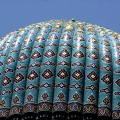BIBI KHANUM MOSQUE
Go there and contact
For the traveler arriving by car from Tashkent, the immense blue dome of Bibi Khanum, emerging behind the compact, motley crowd on its way to the market, is one of the first images of Samarkand. It was in 1399, on his return from his campaign in India - where his troops had laid waste to the temples of Zoroastrian and Hindu infidels - that Tamerlane commissioned the construction of the Masjid-i-Jami mosque, known today as Bibi Khanum, after the daughter of the Emperor of China, Tamerlane's favorite wife.
The best architects and craftsmen from Khorassan, Azerbaijan and India set about building what was to be the largest mosque in Central Asia. The best location in the capital was chosen, and Tamerlan laid the foundation stone on the most auspicious day, the fourth day of Ramadan 801 (May 10, 1399). Ninety-five elephants, which Tamerlan had brought back from his conquests in Indohistan, maneuvered the huge blocks of stone needed for the construction. The figure of four hundred and eighty five-meter-high blocks was announced! Entrusting the supervision of the grandiose project to his most loyal collaborators, Tamerlane left for new conquests in Asia Minor, and did not return to Samarkand until July 1404.
According to Ruy Gonzalez de Clavijo, the Castilian ambassador and keen observer who visited Samarkand in August 1404, Tamerlane's first wife was actually Cano. She was the daughter of Chiacao, emperor of the province of Samarkand and former king of Persia and Damascus, and it was in honor of Cano's mother that the mosque was built. Clavijo recounts how, on his return from Asia Minor, Tamerlane deemed the portal too low and had it demolished and then rebuilt (history repeated itself!). He also recounts how the workers, who took turns day and night, were treated rather harshly. Those working in the pits were fed meat like dogs, sometimes with coins to keep them going. The historian Sharaf ad-Din recounts how Tamerlan, on his return in 1404, flew into a rage because Bibi Khanum, who must have been a strong-willed woman, had built a madrasa and mausoleum for herself in his absence, right opposite the mosque. As subsequent archaeological excavations showed, Tamerlane's fury may have been due to the fact that the portal had not been built in parallel with that of the mosque.
Whatever the real reason, here's the story: "While Tamerlane was away at war, Bibi Khanum decided to surprise him by erecting the tallest mosque ever built. Urged to hurry, the architect finally extracted a kiss in exchange for his promise to finish the work on time. The kiss was so scorchingly hot that Bibi Khanum still bore the scars (on her cheek!) when the emperor returned. The emperor flew into a rage. The felonious architect climbed to the top of one of the minarets and flew off forever to Persia. Bibi Khanum was hurled from the top of another minaret, and Tamerlane gave the order that all women in the empire were to wear veils, so that there would be no temptation when husbands went to war!
At the time of its construction, the complex comprised four marble-paved galleries, covered with 400 domes and supported by 400 marble columns, surrounding an immense inner courtyard measuring 130 m by 102 m. Two 50 m-high minarets stood on either side of the 35 m-high entrance portal and the 40 m-high portal of the main prayer hall. Four further minarets stood at each outer corner of the courtyard. To the north and south, two smaller mosques, each adorned with a dome resting on a lavishly decorated cylindrical drum, looked out towards the center of the courtyard, where rested on a marble lectern Osman's Koran: Islam's second-largest Koran, dating from the 7th century, which Tamerlane brought back from Damascus. It is said that the suras were written in such large characters that the imams could read them from the top of the colonnade.
Itis also said that, as soon as it was completed, the mosque began to fall into disrepair. The architects' haste and earthquakes, one of which had its epicenter in the very center of the mosque, did the rest. Armin Vambery, the fake dervish who managed to visit Samarkand in 1863, described a badly damaged monument, used as a garage for carts. Ten years later, Eugène Schuyller, also visiting Samarkand, described the courtyard of the mosque as having been transformed into a cotton market. However, the large marble lectern on which the Osman Koran was placed was still there. He also recounted the popular belief that, to cure back pain, it was necessary to crawl between the nine short, thick pillars that supported the lectern. Another superstition was that barren women would crawl into the lectern on an empty stomach in the morning, so as to be able to procreate. Even today, women can be seen crawling between these pillars... The restorers worked for over forty years to gradually restore the mosque to its original form. The three domes have reappeared, but those of the north and south mosques are already losing their blue ceramic decorations.
Did you know? This review was written by our professional authors.
Members' reviews on BIBI KHANUM MOSQUE
The ratings and reviews below reflect the subjective opinions of members and not the opinion of The Little Witty.






certaines parties sont toujours interdites car ne réfection